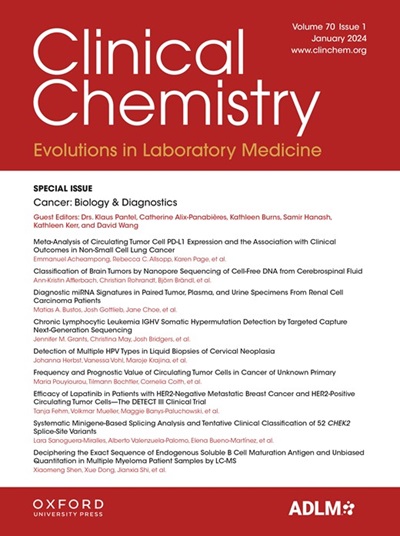利用长读数测序在转录组水平重建和分析全长免疫谱系
IF 7.1
2区 医学
Q1 MEDICAL LABORATORY TECHNOLOGY
引用次数: 0
摘要
背景 由于免疫复合物(IR)的多样性,使用传统的短读数测序技术重建全长 IR 已被证明具有挑战性。方法 利用线性滚圆扩增和纳米孔测序技术开发了全长 IR 测序(FLIRseq)工作流程。质粒混合物和基于短读数的商业 B 细胞受体/T 细胞受体测序(BCR/TCR-seq)验证了其准确性和定量能力。使用 FLIRseq 分析了 8 名急性淋巴细胞白血病患者、3 名过敏性疾病患者、4 名银屑病患者和 5 名前列腺癌患者组织和外周血中的 IRs。结果 FLIRseq 读数的错配率和间隙率低于纳米孔读数,识别率高于纳米孔读数(所有 P < 2.2 × -16)。FLIRseq 对成分的相对定量与实际定量一致(P > 0.05)。FLIRseq 比 BCR/TCR-seq 更优越,它提供了长互补决定区 3、B 细胞异型和很少使用的 V 基因序列。在白血病缓解期患者中,FLIRseq 观察到克隆型多样性增加(P < 0.05),异常 BCRs/TCRs 百分比下降。对于过敏性疾病或银屑病患者,FLIRseq能直接揭示V(D)J重组和特异性免疫球蛋白类别。与前列腺癌组织相比,银屑病组织淋巴细胞中偏向 T 细胞受体 β 链的全长 V 段显示出更一致的 AlphaFold2 预测蛋白结构(P < 0.05)。结论 FLIRseq能对直接V(D)J重组和免疫球蛋白类别进行无偏见的全面分析,从而有助于确定致病机制的特征、监测最小残留病和定制收养细胞疗法。本文章由计算机程序翻译,如有差异,请以英文原文为准。
Full-Length Immune Repertoire Reconstruction and Profiling at the Transcriptome Level Using Long-Read Sequencing
Background Due to the diversity of the immune repertoire (IR), reconstructing full-length IR using traditional short-read sequencing has proven challenging. Methods A full-length IR sequencing (FLIRseq) work flow was developed with linear rolling circle amplification and nanopore sequencing. Its accuracy and quantification ability were verified by plasmid mixtures and commercial B-cell receptor/T-cell receptor sequencing (BCR/TCR-seq) based on short reads. IRs in tissues and the peripheral blood from 8 patients with acute lymphoblastic leukemia, 3 patients with allergic diseases, 4 patients with psoriasis, and 5 patients with prostate cancer were analyzed using FLIRseq. Results FLIRseq reads had lower mismatch rates and gap rates, and higher identify rates than nanopore reads (all P < 2.2 × −16). The relative quantification of components by FLIRseq was consistent with the actual quantification (P > 0.05). FLIRseq had superiority over BCR/TCR-seq, providing the long complementarity-determining region 3, B-cell isotype, and the rarely used V gene sequence. FLIRseq observed an increase in clonotype diversity (P < 0.05) and a decrease in the percentage of abnormal BCRs/TCRs in patients with leukemia in remission. For patients with allergic diseases or psoriasis, FLIRseq provided direct insights into V(D)J recombination and specific immunoglobulin classes. Compared with that in prostate cancer tissues, the full-length V segment of the biased T-cell receptor β chain from lymphocytes in psoriatic tissues showed a more consistent AlphaFold2-predicted protein structure (P < 0.05). Conclusions FLIRseq enables unbiased and comprehensive analyses of direct V(D)J recombination and immunoglobulin classes, thereby contributing to characterizing pathogenic mechanisms, monitoring minimal residual disease, and customizing adoptive cell therapy.
求助全文
通过发布文献求助,成功后即可免费获取论文全文。
去求助
来源期刊

Clinical chemistry
医学-医学实验技术
CiteScore
11.30
自引率
4.30%
发文量
212
审稿时长
1.7 months
期刊介绍:
Clinical Chemistry is a peer-reviewed scientific journal that is the premier publication for the science and practice of clinical laboratory medicine. It was established in 1955 and is associated with the Association for Diagnostics & Laboratory Medicine (ADLM).
The journal focuses on laboratory diagnosis and management of patients, and has expanded to include other clinical laboratory disciplines such as genomics, hematology, microbiology, and toxicology. It also publishes articles relevant to clinical specialties including cardiology, endocrinology, gastroenterology, genetics, immunology, infectious diseases, maternal-fetal medicine, neurology, nutrition, oncology, and pediatrics.
In addition to original research, editorials, and reviews, Clinical Chemistry features recurring sections such as clinical case studies, perspectives, podcasts, and Q&A articles. It has the highest impact factor among journals of clinical chemistry, laboratory medicine, pathology, analytical chemistry, transfusion medicine, and clinical microbiology.
The journal is indexed in databases such as MEDLINE and Web of Science.
 求助内容:
求助内容: 应助结果提醒方式:
应助结果提醒方式:


